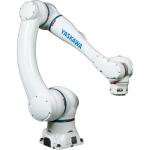Ox
Diamond
- Joined
- Aug 27, 2002
- Location
- Northwest Ohio
These new fangled cobots I guess look sleek and clean, but they appear that they would be a nightmare to have to wrench on? There is nothing exposed. The motors, and even the end effector's I/O has got to be all tucked up in there somewhere. Seems that motors could git hot if working in a warm setting? Are we not expecting cabling issues much quicker with bending/twisting much tighter?
It appears that the biggest difference between the "robot" and the "cobot" is the effort to nix pinch points.
???


----------------------
Think Snow Eh!
Ox
It appears that the biggest difference between the "robot" and the "cobot" is the effort to nix pinch points.
???


----------------------
Think Snow Eh!
Ox

